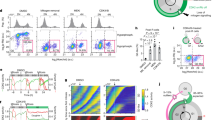Abstract
WHEN “normal” fibroblasts are deprived of serum they cease growing and accumulate in the G1 or G0 stage of the cell cycle1. On restoration of serum, the cells begin to enter S phase quasi-synchronously after a well defined lag period which seems to be characteristic of the cell type. Following the studies of Todaro et al.2, Bürk3, and Temin4, it is widely believed that exposure to serum for only a portion of this lag period is sufficient to commit the cells irreversibly to initiate a round of DNA replication. Thus, removal of the serum after only a few hours, and before the end of the lag period, does not affect subsequent DNA synthesis in a significant proportion of the population. It has been apparent, nevertheless, that the proportion of such “committed” cells depends on the duration of the serum pulse2–5. Indeed, the relationship between the length of exposure to serum and the proportion of committed cells is approximately linear with time and (with 3T3 cells) extends beyond the end of the lag phase itself (Fig. 1). Clearly, some cells which are stimulated to initiate DNA synthesis during continuous exposure to serum are not committed by the end of the lag period, since removal of the serum at this point reduced the proportion of labelled cells, at 24 h, from 76 to 53% (Fig. 1b).
Similar content being viewed by others
References
Brooks, R. F., in Structure and Function of Plasma Proteins, 2 (edit by Allison, A. C.)(Plenum, London, in the press).
Todaro, G. J., Lazar, G. K., and Green, H., J. cell. comp. Physiol., 66, 325–334 (1965).
Bürk, R. R., Expl Cell Res., 63, 309–316 (1970).
Temin, H. M., J. cell. Physiol., 78, 161–170 (1971).
Bombik, B. M., and Baserga, R., Proc. natn. Acad. Sci. U.S.A., 71, 2038–2042 (1974).
Gunther, G. R., Wang, J. L., and Edelman, G. M., J. Cell Biol., 62, 366–377 (1974).
Brooks, R. F., J. cell. Physiol., 86, 369–378 (1975).
Clarke, G. D., and Smith, C., J. cell. Physiol., 81, 125–132 (1973).
Schor, S., and Rozengurt, E., J. cell. Physiol., 81, 339–346 (1973).
Smith, J. A., and Martin, L., Proc. natn. Acad. Sci. U.S.A., 70, 1263–1267 (1973).
Rubin, H., and Steiner, R., J. cell. Physiol., 85, 261–270 (1975).
Smith, J. A., and Martin, L., in Cell Cycle Controls, (edit. by Padilla, G. M., Cameron, I. L., and Zimmerman, A.), 43–60 (Academic, New York, 1974).
Todaro, G. J., and Green, H., J. Cell Biol., 17, 299–313 (1963).
Vogt, M., and Dulbecco, R., Proc. natn. Acad. Sci. U.S.A., 46, 365–370 (1960).
Holley, R. W., and Kiernan, J. A., Proc. natn. Acad. Sci. U.S.A., 60, 300–304 (1968).
Jainchill, J. L., and Todaro, G. J., Expl Cell Res. 59, 137–146 (1970).
Author information
Authors and Affiliations
Rights and permissions
About this article
Cite this article
BROOKS, R. Regulation of the fibroblast cell cycle by serum. Nature 260, 248–250 (1976). https://doi.org/10.1038/260248a0
Received:
Accepted:
Issue Date:
DOI: https://doi.org/10.1038/260248a0
- Springer Nature Limited
This article is cited by
-
Commentary: locating the restriction point
Cell Division (2023)
-
Meta-analysis reveals conserved cell cycle transcriptional network across multiple human cell types
BMC Genomics (2017)
-
Exit from quiescence displays a memory of cell growth and division
Nature Communications (2017)
-
Dose- and time-dependent expression patterns of zebrafish orthologs of selected E2F target genes in response to serum starvation/replenishment
Molecular Biology Reports (2011)
-
Thetef1 box, a ubiquitouscis-acting element involved in the activation of plant genes that are highly expressed in cycling cells
Molecular and General Genetics MGG (1995)





